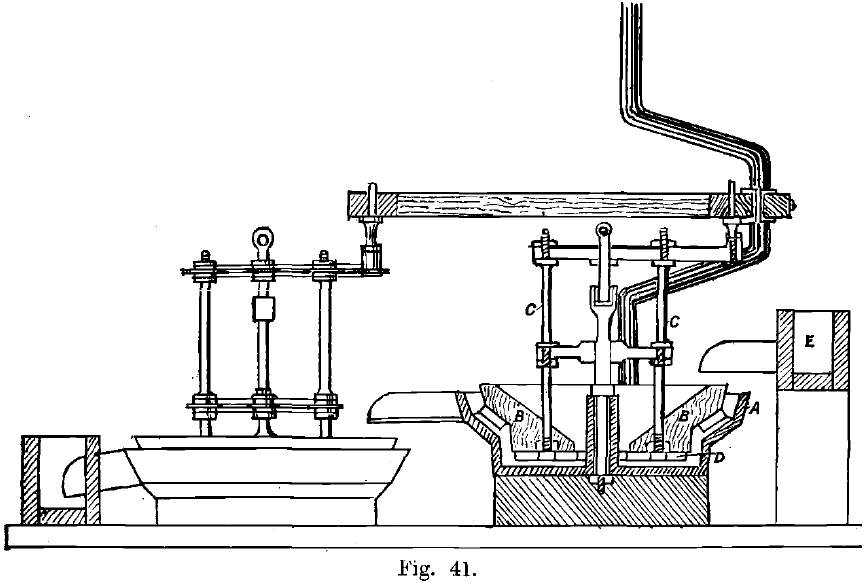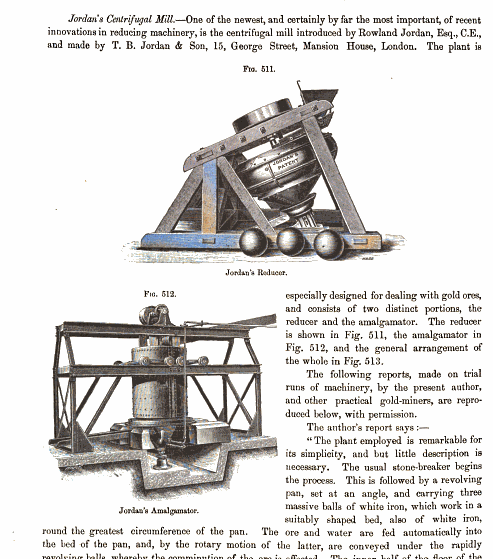In the Griffin Mill, there is a single roller suspended in a similar way to the rollers in a Huntington mill. The roller is about 18 inches in diameter, and rolls on the inside of a die ring 30 inches in diameter. It takes material up to 1½ inches in diameter, and crushes either wet or dry. It does not appear to be used anywhere either as an amalgamator or to prepare ore for amalgamation, but is described here for convenience. In December, 1904, 34 Griffin mills and 14 Huntington mills were in use in Western Australia preparing ore for cyaniding.
Among other roller mills, the Bryan Mill is one of the most successful. It resembles the Chilian mill and consists of an annular mortar in which are fixed segmental annular steel dies. The ore is crushed by three vertical rollers with fixed horizontal axles, which rotate in journals fixed to an annular horizontal rotating plate. This plate revolves round the central axis of the machine, and the rollers are made to run round on the dies. A scraper follows each roller to keep the dies clean and to discharge the pulp through the screens which form the wall of the trough all round. The pulp runs round at the rate of 300 feet per minute or more at the periphery, the plate moving the rollers making 30 revolutions per minute. The mill is suitable for hard as well as for soft ores. The capacity of a 4-foot mill is about 15 or 20 tons of quartz ore per day through a 40-mesh screen. The Bryan Mill has been introduced on the Pacific Coast, in Mexico, and in Australia for crushing gold ores.
The Chilian Mill (see also p. 93), formerly used in the Patio process and for preparing ores for barrel amalgamation, has recently been re-introduced into the United States for crushing gold ores requiring very fine pulverisation. In one mill, sent to Mexico, the rollers were 8 feet in diameter and weighed 10 tons each, the shell or tire being 6 inches thick. These made 12 revolutions per minute, and the capacity was 18 tons of ore per day through a screen of 120 mesh. They are more usually employed for coarse crushing.
Tyrolean Mill
In Hungary, in Transylvania, and in the Tyrol, the principle of separation of the operations of crushing and amalgamation is still successfully used, the mills employed having a strong resemblance to the amalgamation pans described below (pp. 164-169). In some districts of Hungary and Transylvania, Californian stamps have been recently introduced, displacing to some extent the square German stamps, but the amalgamation is still effected in bowls or pans, which are the modern equivalents of the old Tyrolean mills still to be found at work in certain retired valleys in the Eastern Alps (see p. 98). The best known of these modern machines are the Schemnitz Mill and the Lazzlo Amalgamator.
The Schemnitz Mill, shown in Fig. 41, closely resembles the ancient form and is always used in pairs, one overflowing into the other. It consists of a cast-iron bowl, about 2 feet in diameter at the top and 18 inches at the bottom, with an internal depth of 7 inches. A massive wooden muller, B, hollowed out inside in the form of a cone, is suspended in the bowl by the iron rods, C, and is revolved at the rate of about twenty turns per minute. About 26 lbs. of mercury are charged into the bowl, and the lower face of the muller is set with twenty iron teeth, D, placed radially, which almost touch the mercury and force the pulp (delivered into the mill from the trough, E) outwards towards the periphery of the bowl, whence it overflows into the second mill.
In the neighbourhood of Schemnitz, in Hungary, lead ores, containing 2 to 4 dwts. of gold per ton are crushed by stamps and are treated in these mills, the tailings being concentrated for smelting. At Nagybanya, in Hungary, the loss of mercury in these mills amounts to from ½ to 1 part for each part of bullion recovered. Thus at the Kreuzberg works, near Nagybanya, in one month 155 metric tons of ore were treated, and 1 .957 kilogrammes (62.9 ozs.) of gold were recovered with the loss of 1.9 kilogrammes of mercury, and in another month 754.5 metric tons of ore yielded 5.756 kilogrammes (185.8 ozs.) of gold, with the loss of 2.9 kilogrammes of mercury. The clean-up usually takes place once or twice a month, and the capacity of each pair of mills is from ¾ to 1 ton of ore per day.
The Lazzlo Amalgamator has only lately come into use, but has already proved itself to be of value in Transylvania. It differs from the Schemnitz mill mainly in having a flat-bottomed bowl, which is furnished with two circular iron partitions dividing the bowl into three concentric compartments. The ore is fed into the centre one and overflows into the others in succession, and thence into a second smaller bowl. The muller is of iron, and dips into each compartment of the bowl compelling the pulp to pass down and come in contact with the mercury three times before it escapes, and the gold, owing to its density, does not readily pass upwards and over the partitions.
At the Fuzesd Dreifaltigkeit Mine, near Boicza, in Hungary, the ore is crushed by Californian stamps, the capacity of which is 0.8 ton per head in 24 hours, and then passed through Lazzlo amalgamators. The amalgam is collected in settling pans, which resemble the amalgamators, but have no iron teeth, and the tailings are classified in spitzkasten, and concentrated by passing over buddies and then over canvas tables. The auriferous pyrites is caught on the buddies and sold to smelters, but the product of the canvas tables is very rich in free gold, and is ground with mercury in iron mortars by hand with pestles. The Lazzlo amalgamators are about 25 inches in diameter, and each pair treats from 1.7 to 2 tons of ore in twenty-four hours, 75 to 80 per cent, of the gold being saved. The loss of mercury is about 1 oz. per ton of ore, and the power required for twenty-four pairs of amalgamators and eight settlers is 4 H.P.
At a mine near Brad, in Transylvania, each pair of amalgamators treats from 3 to 3½ tons of ore per day, but only 55 per cent. of the gold is extracted, the tailings being treated in American pans, and concentrated on Bilharz tables for smelting. Specimens of the ore containing visible gold are amalgamated by hand in mortars, and the rest contains about 8 dwts. per ton.

